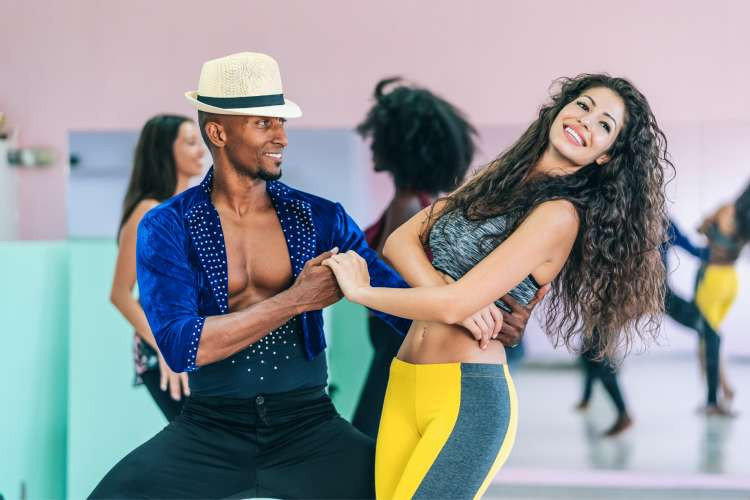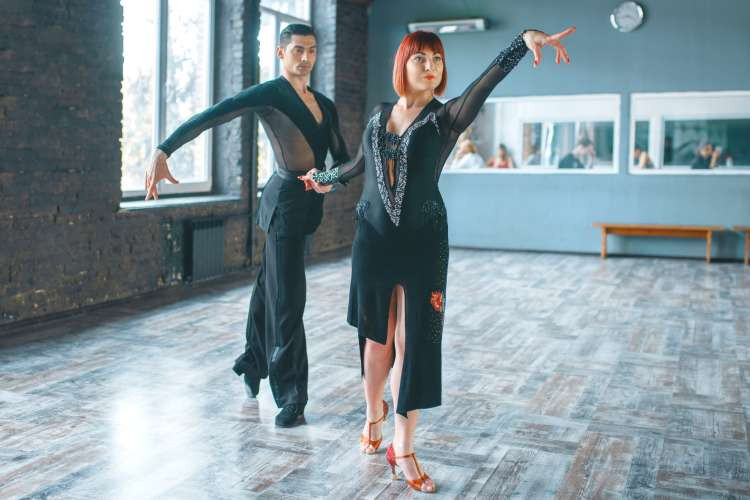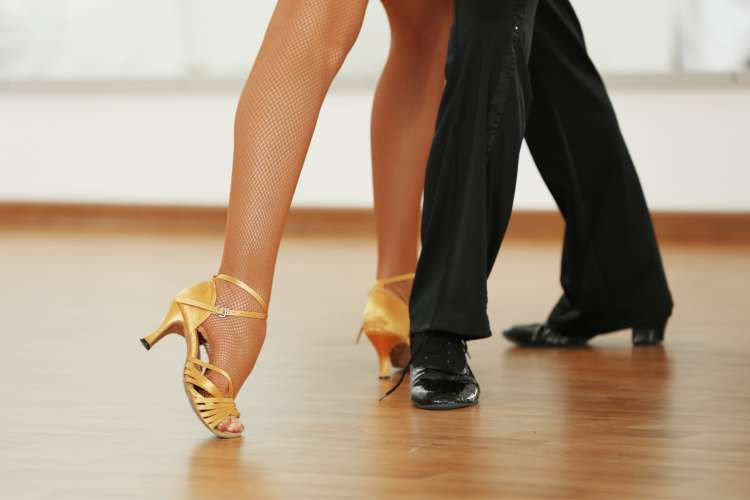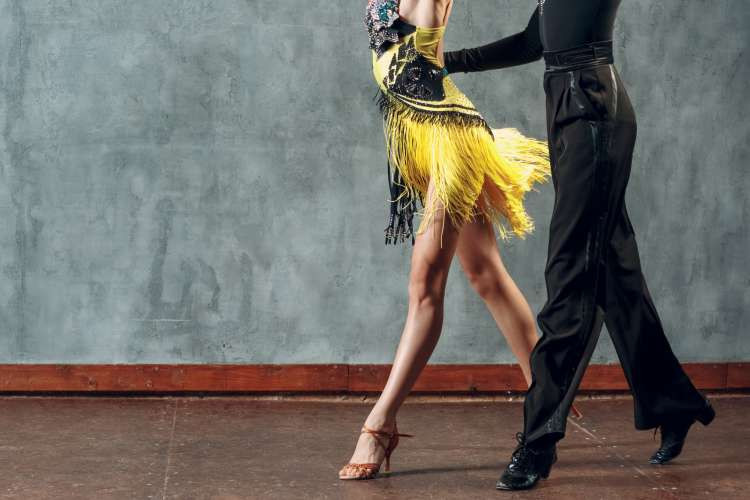How To Do Salsa Dance Steps? Salsa dancing is a vibrant and passionate dance that can be enjoyed by people of all ages and skill levels, and ten-dance.com is here to guide you. Salsa is more than just a dance; it’s a journey of rhythm, connection, and self-expression. Whether you’re looking for salsa dance lessons, basic salsa steps, or salsa dancing techniques, learning to salsa is an exciting adventure. Discover the joy of Latin dance and enhance your dance experience with us!
1. What Makes Salsa Dancing So Appealing?
Salsa dance is appealing because it is lively, elegant, and creative, it has become one of the most popular dance creations of the past 100 years. The dance combines an off-beat pattern with plenty of style, beginners are only a few steps away from dancing like professionals.
Salsa dancing is appealing for several reasons:
- Social Interaction: Salsa dancing is inherently social, providing opportunities to connect with others who share a passion for music and movement. According to a study by the University of California, Berkeley, participating in social dance activities like salsa can reduce feelings of loneliness and increase social bonding.
- Physical Fitness: It offers a great workout. According to a study from the Journal of Physical Activity and Health, regular salsa dancing can improve cardiovascular health, strength, and flexibility.
- Cultural Experience: Salsa provides a connection to Latin American culture. The dance is a fusion of Cuban, Puerto Rican, and other Latin rhythms, giving dancers a taste of the rich cultural heritage.
- Creative Expression: With its improvisational nature, salsa allows dancers to express themselves creatively. Whether it’s through shines, styling, or partner work, there’s always room to add your unique flair to the dance.
- Mental Stimulation: Learning salsa steps and combinations challenges the mind and enhances cognitive function. According to research from Stanford University, learning new dance patterns can improve memory and coordination.
- Stress Relief: The energetic movements and lively music can be a great way to release stress and boost mood. According to a study in the journal Arts in Psychotherapy, dance therapy can reduce symptoms of anxiety and depression.
2. Is Learning How to Salsa Dance Difficult?
Learning how to do salsa dance steps isn’t too hard, but it varies based on your previous dance background or natural feel for dance. Anyone can learn the salsa, no matter their beginning level, with just a little bit of practice.
2.1 Start with the Basics
Beginning with the basics, like the basic step, is the best way to master the dance. According to the Arthur Murray Dance Centers, many professional dancers still drill basic steps to keep their bodies in shape.
2.2 Take a Salsa Dance Class
Professional instructors in interactive dance classes can help you learn how to salsa dance. Salsa dance classes are available across the nation from dance classes in Colorado Springs and dance classes in Denver to dance classes in Las Vegas.
Taking a dance class is the perfect chance to learn how to dance salsa from an expert. You can also learn salsa from home with a live instructor by signing up for online dance classes. With ten-dance.com, you can connect with experienced instructors who offer personalized guidance and feedback.
 Two salsa dancers smiling and posing during a dance class
Two salsa dancers smiling and posing during a dance class
2.3 Practice Regularly
Practice regularly, even if it’s just for a few minutes each day, to reinforce what you’ve learned and improve your muscle memory. Set realistic goals for yourself and celebrate your progress along the way.
3. What Role Does Salsa Music Play in the Dance?
Salsa music plays a vital role in salsa dancing, it shapes the moves, feel, and cultural context of the dance. Music is key to learning how to do salsa dance steps. Salsa music and the dance known as the salsa originated in New York City clubs in the 1950s and grew to the height of its popularity in the 1960s, according to Encyclopedia Britannica.
3.1 Origins and Influences
Salsa music originated in the vibrant cultural melting pot of New York City in the 1960s and 70s. It is a mixture of African, Cuban, Puerto Rican, and other Latin American musical traditions to create a syncopated style.
According to the Smithsonian Institution, salsa music reflects the diverse influences of Latin American immigrants in New York, blending traditional rhythms with urban sounds.
3.2 Key Instruments
The clave is a percussion instrument that is made of two wooden sticks, and it creates the unique sound of salsa music. According to the Library of Congress, the clave rhythm is the heartbeat of salsa music, providing the foundation for all other instruments. Salsa music often features the trumpet, tres, and drums, as evidence of salsa’s jazz and big band influences.
3.3 Rhythm and Timing
The basic salsa rhythm is based on an eight-beat count, with dancers typically stepping on beats 1, 2, 3, and 5, 6, 7. The pauses on beats 4 and 8 create the syncopated feel that is characteristic of salsa.
3.4 Connection to Dance
Salsa music guides the dancers’ movements, dictating the timing, tempo, and overall energy of the dance. Dancers listen to the music and interpret its nuances through their steps, shines, and partner work.
4. What Are the Different Salsa Dance Styles?
Like contemporary dance, the salsa dance comes in many forms. The dance itself was born in New York City to accompany salsa music. Learning the various styles can expand a dancer’s knowledge and provide more ways for individuals to express themselves.
4.1 New York Style
The New York style of salsa is a linear dance where the following dancer leads rather than the lead dancer. According to the World Salsa Federation, New York style salsa emphasizes clean lines, intricate footwork, and precise timing. It’s a great style for beginners learning how to do salsa dance steps for the first time.
4.2 Los Angeles Style
The Los Angeles style of salsa is a linear dance, but in this style, the lead dancer leads the dance. According to the Los Angeles Salsa Congress, LA style salsa is known for its fast-paced turns, dramatic styling, and acrobatic moves.
4.3 Circular Style
In the circular style of salsa, dancers circle around one another rather than dance linearly with one another. Cuban and Colombian salsa dances follow this circular style. According to the International Salsa Magazine, Cuban style salsa, also known as Casino, is characterized by its playful interactions, intricate partner work, and emphasis on musicality.
4.4 Other Styles
There are several other styles of salsa that dancers can learn. These include:
- Puerto Rican Style: Characterized by its elegant styling, intricate footwork, and emphasis on musicality.
- Colombian Style (Cali Style): Known for its rapid footwork, energetic movements, and circular patterns.
- Miami Style: A fusion of Cuban and LA styles, characterized by its smooth transitions, sensual styling, and emphasis on social dancing.
Learning how to do salsa dance steps in all three styles will make you a true salsa-dancing star!
 Salsa dancers performing on a stage
Salsa dancers performing on a stage
5. What Are the Five Basic Steps of Salsa?
The salsa dance has five main steps founded on the basic front-to-back step pattern. When you first learn how to do salsa dance steps, practicing this front-to-back step pattern is key to mastering the dance.
5.1 Basic Salsa Step
When dancing salsa, there is a lead dancer and a follow dancer. The basic salsa steps for the lead dancer are as easy as 1, 2, 3 — front, center, front — and 5, 6, 7 — back, center, back. For the follow dancer, these steps are reversed: back, center, back, then center, front, center.
Here’s a breakdown of the basic salsa step:
- Begin with your feet together.
- On beat one, step forward with your left foot.
- On beat two, shift your weight to your right foot.
- On beat three, step your left foot to center again.
- Beat four is a pause.
- On beat five, step back with your right foot.
- On beat six, shift your weight to center.
- On beat seven, step your right foot to center again.
- Beat eight is another pause.
- Repeat these steps until you’ve mastered how to do the basic salsa dance steps!
5.2 Basic Salsa Side Step
The side basic step is similar to the basic step but is done to the side rather than front to back. You will be stepping from side to side in this dance step.
- Lead dancers begin with the left foot and follow dancers with the right.
- On beat one, step out to the left with the left foot.
- On beat two, shift weight to your right foot at center.
- On beat three, step left for back to center.
- Pause on beat four.
- On beat five, step out to the right with the right foot.
- On beat six, shift weight to left foot at center.
- On beat seven, step right foot back to center.
- Pause on beat eight.
- Repeat these steps and combine the side basic step with the basic step as you practice.
 A couple dancing salsa, showcasing their footwork
A couple dancing salsa, showcasing their footwork
5.3 Rotating the Follow Dancer
Rotating the follow dancer in a fun spin will add flair to your basic salsa dance. To do this salsa dance step, the lead dancer spins the follow dancer on count five of the basic dance step. After the spin, the dance continues with the basic salsa dance step.
5.4 Cross Body Lead
For this salsa dance step, you will need to combine both the basic step and the basic side step. The lead dancer steps to the side on beat two and rotates their body to be perpendicular to the follow dancer on beat three.
The lead dancer then leads the follow dancer across the floor in front of them so that the dancers change positions, all while maintaining the basic step pattern.
5.5 Cross Body Lead With Inside Turn
This step combines the cross body lead with a turn. The lead dancer will turn the follow dancer.
Perform a basic salsa dance step with a cross body lead and then the basic steps with a turn on beat five. Then continue in the basic step.
5.6 Tips for Beginners
Here are some tips for beginners when learning how to do salsa dance steps:
- Stay Relaxed: As you practice how to salsa dance, keep your hips and arms loose. This is a fluid dance that moves with the music — let your body sway with the rhythm.
- Listen to the Music: Pay attention to the rhythm and timing of the music.
- Start Slow: Begin with a slower tempo and gradually increase speed as you become more comfortable with the steps.
- Practice Regularly: Consistent practice is key to mastering the basic salsa steps.
- Have Fun: Relax, enjoy the music, and let your personality shine through your dance.
Once you have mastered how to do salsa dance steps with the basic salsa dance steps, add personality and flair to the dance with hand and hip movements, or “shines,” when you break free from your partner and perform solo. Salsa dancing is all about feeling the beat of the music and letting it flow through the body in dance.
6. How Do You Salsa Dance With a Partner?
The salsa dance was made to be danced with a partner. To salsa dance with a partner, simply grab a friend and practice the techniques above until you both can dance with ease.
6.1 Communication
Clear and effective communication is essential for successful partner dancing. The lead dancer should clearly communicate their intentions through physical cues, such as hand pressure, body positioning, and eye contact.
6.2 Connection
Maintaining a strong connection with your partner is key to feeling the music and moving as one. This connection is achieved through physical touch, shared energy, and mutual understanding of the dance.
6.3 Trust
Trust is essential for both partners to feel comfortable and confident on the dance floor. The follow dancer must trust the lead dancer to guide them safely through the steps and turns.
6.4 Improvisation
Salsa dancing is often improvisational, with partners responding to each other’s movements and the music in the moment. This requires flexibility, creativity, and a willingness to try new things.
6.5 Musicality
Listening to the music and interpreting its nuances through your movements is essential for adding flair and personality to your partner dancing. Pay attention to the rhythm, melody, and dynamics of the music, and let it guide your steps.
If you’re a beginner salsa dancer, you can learn how to do salsa dance steps with a partner in a dance class or through online videos or articles. ten-dance.com offers a variety of resources for learning salsa with a partner, including video tutorials, step-by-step instructions, and tips for improving your communication and connection.
 A couple in formal attire dancing salsa together
A couple in formal attire dancing salsa together
7. How Can You Practice Salsa Dancing Solo?
Perhaps your partner is busy or your social circle isn’t as interested in learning how to do salsa dance steps, and you’re wondering “How can I practice salsa dancing alone?”
The answer is simple. Just practice the basic salsa steps solo!
7.1 Focus on Technique
Practicing solo provides an opportunity to focus on technique without the added pressure of a partner. Pay attention to your posture, footwork, and body movements, and make corrections as needed.
7.2 Experiment with Styling
Solo practice is also a great time to experiment with styling and add your personal flair to the dance. Try different hand movements, hip motions, and facial expressions to express yourself and connect with the music.
7.3 Listen to the Music
Pay attention to the rhythm, melody, and dynamics of the music, and let it guide your movements. Experiment with different tempos and styles of salsa music to challenge yourself and expand your musicality.
7.4 Record Yourself
Recording yourself dancing solo can be a valuable tool for identifying areas for improvement. Watch the video and analyze your technique, styling, and musicality, and make adjustments as needed.
The key to learning salsa is practice, and practicing how to do salsa dance steps alone is a low-pressure way to do so. As you dance solo, you can practice your counting, your combinations, and your turn techniques. This is also a great time to practice your body movements — the extra flair that brings life to your personal salsa dance style!
8. Where Can You Find Salsa Dance Classes and Events in the USA?
Finding salsa dance classes and events is easy with today’s resources. Here are some places you can look:
- Online Directories: Websites like ten-dance.com, Yelp, and Eventbrite list local dance studios, instructors, and events.
- Social Media: Facebook groups and Instagram hashtags dedicated to salsa dancing often share information about classes, workshops, and social dances.
- Community Centers: Local community centers and recreation departments may offer affordable salsa classes for beginners.
- Dance Studios: Many dance studios specialize in Latin dances like salsa and offer classes for all levels.
- Universities and Colleges: Some universities and colleges have dance programs or clubs that offer salsa classes or social dances.
- Word of Mouth: Ask friends, coworkers, or other dancers for recommendations on classes or events in your area.
If you want to learn how to salsa dance like a pro, taking a salsa dance class near you with a world-class instructor is the most straightforward (and fun!) way to do so. You’ll get a live how-to on salsa dance steps and tips for practicing the steps at home, as well as a lively interactive environment.
Ten-dance.com is your go-to resource for finding the best salsa dance classes and events in the USA. We provide a comprehensive directory of dance studios, instructors, and events, as well as reviews, ratings, and detailed information to help you make the right choice.
9. How Can Ten-Dance.com Help You Learn Salsa Dancing?
Ten-dance.com provides many resources to help you learn salsa dancing:
- Comprehensive Guides: Step-by-step instructions on basic salsa steps, partner work, and styling techniques.
- Video Tutorials: High-quality video lessons taught by experienced salsa instructors.
- Directory of Classes and Events: Find local salsa classes, workshops, and social dances near you.
- Community Forum: Connect with other salsa dancers, share tips, and ask questions.
- Personalized Recommendations: Receive personalized recommendations for classes and instructors based on your skill level and goals.
- Expert Advice: Articles and blog posts written by dance experts on topics such as technique, musicality, and styling.
- Latest Updates: Information on the latest salsa dance trends, events, and news.
- Engaging Content: Fun and engaging content that will inspire you to explore the world of salsa dancing.
10. Frequently Asked Questions (FAQs) About Salsa Dance Steps
Here are some of the most frequently asked questions about salsa dance steps:
- What are the basic steps of salsa?
The basic steps of salsa involve stepping forward, backward, or to the side on beats 1, 2, 3, and 5, 6, 7, with pauses on beats 4 and 8. - What is the difference between leading and following in salsa?
The lead dancer guides the dance, indicating steps and turns, while the follow dancer responds to the lead’s cues and adds their own styling. - How do I find a good salsa instructor?
Look for instructors with experience, a positive teaching style, and a focus on technique and musicality. - What should I wear to a salsa dance class?
Wear comfortable clothing that allows you to move freely, and shoes that are easy to turn in. - How long does it take to learn salsa?
The time it takes to learn salsa varies depending on your dedication, practice, and natural aptitude for dance. - Can I learn salsa online?
Yes, many online resources offer salsa lessons, but in-person instruction is often more effective for learning proper technique. - What are some common mistakes to avoid when learning salsa?
Common mistakes include not listening to the music, not maintaining proper posture, and not communicating clearly with your partner. - How do I add my own styling to salsa?
Experiment with different hand movements, hip motions, and facial expressions to express yourself and connect with the music. - What is the importance of musicality in salsa?
Musicality is essential for interpreting the music and adding flair and personality to your dance. - Where can I find salsa dance events in my area?
Check online directories, social media groups, and local dance studios for information about salsa dance events in your area.
Ready to take your first step into the vibrant world of salsa dancing? Visit ten-dance.com today to explore our comprehensive resources, find local classes and events, and connect with a passionate community of dancers. Start your salsa journey with us and discover the joy of movement, connection, and self-expression. Address: 60 Lincoln Center Plaza, New York, NY 10023, United States. Phone: +1 (212) 769-7000. Website: ten-dance.com.
